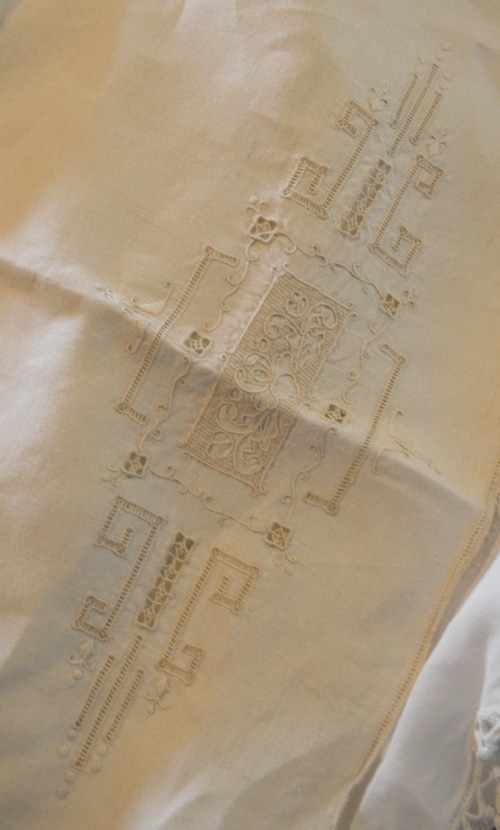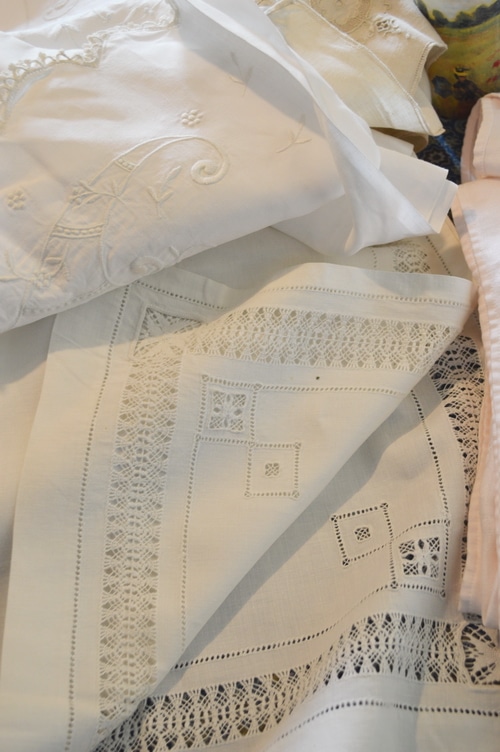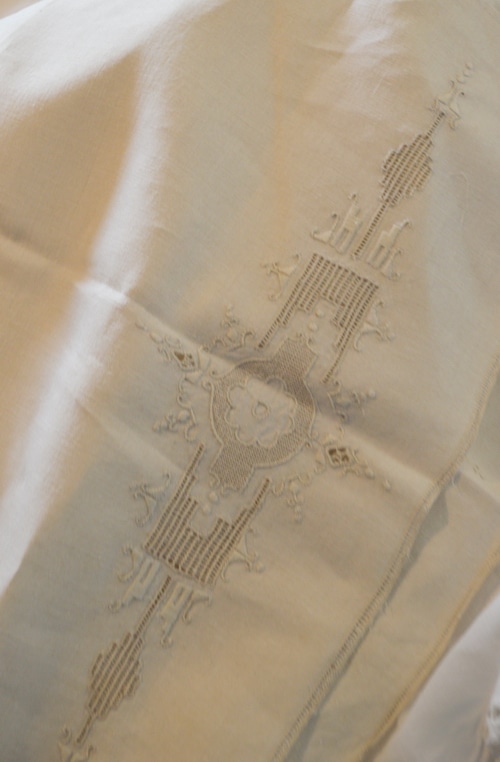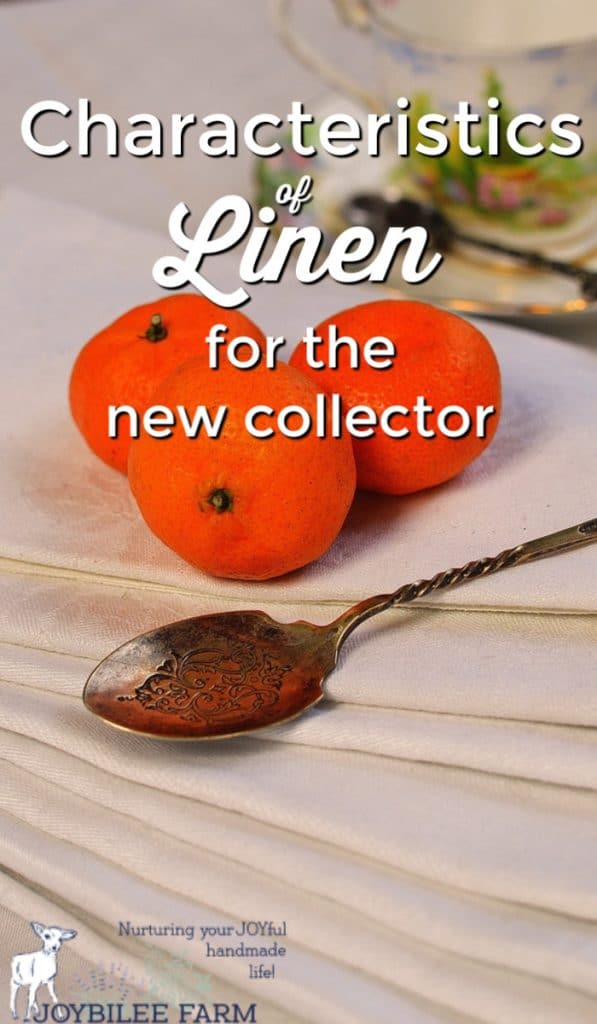Finding linens in secondhand stores, garage sales, and antique malls can be fun. Know the characteristics of linen textiles so you can spot easily spot them
Most likely when you find your first few linen textiles, you won’t know for sure that its linen until you get it home. It takes a bit of experience to learn to know linen’s properties.
Here’s a short tutorial to help you navigate your way through your first treasure hunt for linen textiles.
Linen has body
When you touch the fabric and crush it with your hand and then let it go, real linen will spring back. It will be wrinkled and spring back. The folds of the creases that your hand made will remain rounded rather than crushing flat in your hand.
Cotton will crush flat because it lacks body. Manmade fibers will spring back unchanged and limp.
Linen feels cold and may feel damp
Linen actively absorbs moisture from the air, so when you touch linen fabric it will feel cool. Cotton also absorbs moisture but rather than feeling cool, cotton may feel damp to the touch in a high humidity environment.
Polyester and other petroleum-based fibers do not readily absorb moisture and will feel the same temperature as the surrounding air.

Linen has a nubby texture
Even if your linen textile has a smooth surface and a shiny jacquard weave, it will have shorter nubby fibers in the weave. This is a telltale mark of a real linen textile. It’s so characteristic that these nubby fibers are called “lint.”
Polyester tablecloths that are made to imitate linen, often add the nubs for character. On an older linen tablecloth the nubs will be less noticeable because of the finer weave, but if you hold the textile up to the daylight, you will see the thicker threads among the even, fine threads.
Be aware that modern polyester tablecloths imitate this aspect of linen but are permanent-press, and will not feel cold to the touch. Polyester lacks the body and weight of real linen.
Linen Textiles are often white or white with a border stripe
Linen resists dye and so most traditional linen textiles are white or off-white. Sometimes you’ll find one with a coloured stripe, but rarely will you find one dyed in a solid colour, throughout.
Again, beware cotton or polyester imitations. While linen will get softer with repeat washings, it will retain its body and weight, whereas cotton and polyester, lose their body and weight with repeat washings as this “feel” is added to the fabric with sizing and polymers, which are washed away.

Linen is often woven with a jacquard weave
The jacquard weave puts pictures in the weave of the linen that are the opposite on the other side of the textile. Linen is especially attractive in the jacquard weaving technique, because of the sheen of the linen fibers in the satin weave portion of the pattern, which makes the pattern stand out. Therefore, jacquard weaving, although more expensive to do, requiring more shafts than traditional weaving, was conventionally used with linen textiles.
Often cotton tablecloths will imitate this aspect of linen, but they will lack the body and feel of linen. Cotton tablecloths woven in a jacquard pattern are often dyed in many colours. Linen is rarely dyed.

Linen is stiff after washing
After washing the pectin from the linen plant is revived in the fabric and this gives the fabric stiffness and crispness, that cotton, ramie, and manmade fabrics lack. This is especially noticeable in line-dried textiles.
Linen is resistant to ironing
Linen wrinkles easily and is difficult to iron smooth. It requires the heat of the highest iron setting and dampness to iron smooth. Traditionally linen was mangled with a specialty press that took a cold fabric and crushed it under heavily weighted rollers to get it smooth and crisp.
Cold mangled linen has a wonderful hand that can’t be imitated with steam ironing.
The burn test
If you are still unsure if your textile is made of linen, you can do a burn test. In a safe spot, like the kitchen sink, place a few threads from the hem of the textile in a metal can. Using a candle, touch the flame to the textile. Linen will burn with a yellow flame. It will smell like burnt grass. It will leave white ash. Polyester will melt into a lump of plastic.

Other natural fibers that you might mistake for linen
Ramie (nettle) and hemp both behave very much like linen. Ramie and hemp are also bast fibers like linen. If the cloth is woven in plain weave or a simple balanced twill and is using colour as its design feature, it could be ramie, hemp, or flax-tow.
Tow is the shorter flax fibers that remain when the longer linen fiber is hackled and combed for spinning. It lacks the sheen and longevity of true linen, and is a coarser weave, with more lint.
Once you’ve touched genuine linen and become accustomed to the feel of linen in your hands, you will have success in identifying vintage linen in thrift shops, garage sales, and antique stores. Use these linen properties and give it a try.




Hello,
This article was very helpful. Can you recommend an avenue I can take to research different linen makers? I have a bolt of what I believe is linen with a partial paper label of a winged woman and I would love to know more about it.
Thank you.
I am having trouble identifying linen from my great grandmother. It’s a square handkerchief with a linen disk/pocket tacked on the top. I have 8 of them. Any ideas or thought on who to contact? I can send pics. Thanks! It’s a mystery!
Nice to meet you, Lillace. I’m glad you found it helpful.
Hello, Chris! I want to thank you for this very, very informative post. Even though I studied textiles many years ago I still have difficulty distinguishing linen from cotton from time to time. You’ve been a great help and I look forward to more of your posts! Have a great day! Lillace